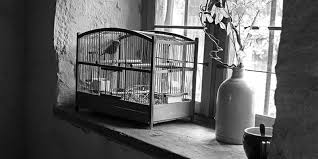"I Know Why the Caged Bird Sings"
is an autobiographical coming-of-age novel written by Maya
Angelou. Published in 1969, it is the first volume of Angelou's seven-volume
memoir series. The book explores themes of racism, identity, self-discovery,
and resilience, providing a powerful account of Angelou's early years.
In Angelou's narrative,
the caged bird represents the oppressed African American community,
while the free bird represents the privileged white community.
The book begins with
Angelou's childhood in Stamps, Arkansas, during the Great Depression. She
describes the challenges she faced growing up in a segregated society and the
impact of racial discrimination on her self-esteem and sense of identity.
Angelou recounts her experiences of racism, such as being denied services due
to her race and witnessing the injustices inflicted upon African Americans.
One of the central
themes of the book is the power of literature and language as a means of escape
and self-discovery. Angelou finds solace in books and poetry, which serve as a
source of inspiration and empowerment throughout her life. Through her love for
reading and writing, she discovers her own voice and the transformative
potential of words.
The memoir also delves
into Angelou's personal struggles, including the trauma of sexual abuse. She
bravely confronts these experiences and their impact on her emotional
well-being. Despite these hardships, Angelou portrays resilience and strength,
emphasizing the importance of perseverance and the ability to rise above
adversity.
"I Know Why the
Caged Bird Sings" is a poignant exploration of the African American experience, capturing the complexities of race, gender, and identity in mid-20th century
America. It highlights the power of literature, the resilience of the human
spirit, and the importance of confronting and overcoming one's past. The book
remains a significant contribution to American literature and a testament to
Maya Angelou's remarkable life and literary talent.
In "I Know Why the
Caged Bird Sings," Maya Angelou vividly portrays the harsh realities of racial discrimination prevalent in the
society she grew up in. Angelou describes the strict segregation enforced
during her childhood in Stamps, Arkansas. She depicts separate facilities for
black and white individuals, such as schools, public transportation, and even
public restrooms. The segregation laws known as Jim Crow laws were designed to
enforce racial separation and perpetuate inequality.
Angelou recounts
instances where African Americans were treated unfairly solely because of their
race. For example, she describes
being refused service at white-owned establishments or being given inferior treatment compared to white
individuals. These experiences highlight the systemic racism and the dehumanising effects of such
discrimination.
The memoir also touches
on the violence and threats faced by
African Americans. Angelou recalls the brutal murder of a young black man,
Emmett Till, and the impact it had on her and the wider community. This event
highlights the extreme racial violence and the fear that permeated the lives of African Americans during that
time.
Angelou explores the
internalized racism within the African American community. She portrays the
damaging effects of societal expectations and stereotypes on the self-esteem and self-perception of individuals.
Through her own experiences, Angelou sheds light on the struggle to overcome
the internalized messages of inferiority
that are ingrained through a racist society.
By vividly depicting
these experiences and reflecting on their profound impact on her life, Angelou
brings to light the deeply ingrained racial
discrimination and inequality faced by African Americans during the era she
writes about. Through her memoir, she raises awareness and promotes
understanding of the systemic racism that shaped her personal journey and the
experiences of many others.
The concept of the free bird and the caged bird is a recurring
metaphor throughout the memoir.
The most obvious
difference is that the free bird
represents freedom, while the caged
bird symbolises confinement. The free bird is able to soar and explore without
limitations, while the caged bird is trapped within the confines of its cage.
The free bird has limitless
opportunities and choices. It can explore new territories, enjoy the
beauty of nature, and experience the world without restrictions. In contrast,
the caged bird is limited in its movements and experiences, confined to the
space of its cage and denied the freedom to explore the world.
The free bird represents privilege, often associated with the white community
in the book. It symbolises the advantages and freedoms enjoyed by those who are
not subjected to racial discrimination. On the other hand, the caged bird represents the oppressed African American community,
facing limitations, discrimination,
and the oppressive systems of racism.
The free bird has the ability to express
itself freely through its songs and flight. It can vocalise its desires, emotions, and experiences
without fear or constraint. In contrast, the caged bird is silenced and
constrained by its surroundings, unable to fully express itself or
communicate its true nature.
The free bird experiences joy,
exhilaration, and the pleasures of freedom. It revels in its ability to explore, fly, and
experience life to the fullest. In contrast, the caged bird suffers from the loss of freedom,
yearning for escape and longing for the same joy and liberation experienced by
the free bird.
Through the contrasting
imagery of the free bird and the caged bird, Angelou emphasizes the stark
disparities and injustices faced by the African American community in a
racially segregated society. The metaphor serves to highlight the desire for
freedom, equality, and the struggles endured by those who are oppressed and
denied their basic rights.









No comments:
Post a Comment
Thanks for your views. We will work on it. Meanwhile, do visit this blog for an interesting Article tomorrow. Have a nice day.